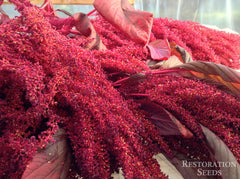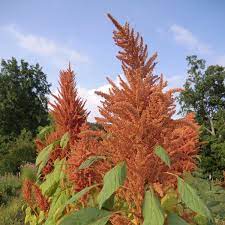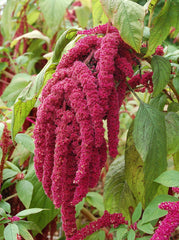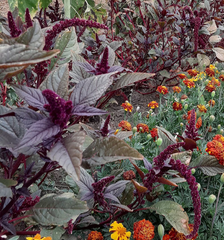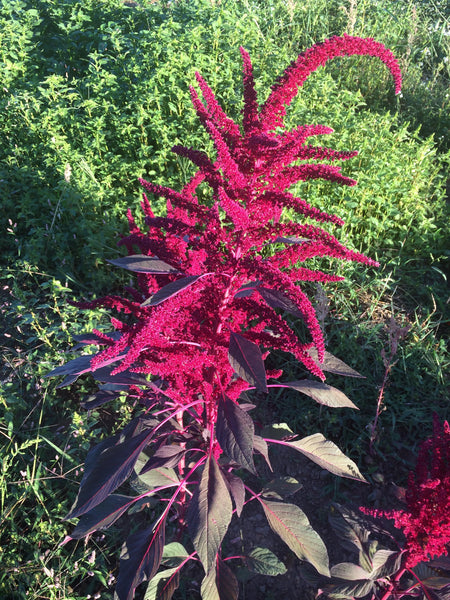Red Giant
"Amaranthus hypochondriacus
HOW TO GROW AMARANTH
Start indoors 4-6 weeks before last frost, plant out or direct seed after frost. Tender annual that does not tolerate frost. If growing for seed, grown in greenhouse in Zone 7B or cooler to avoid early frost. Optimum growing temperatures 60–70˚F. Keep moist until germination. Seeds require light to germinate, press into soil, do not cover. Soil pH 5.5-7.5. Hardiness zones 2-10. Annual.
Days from maturity calculated from the date of seeding. Average 44,000 seeds per ounce. Federal germination standard: 70%. Usual seed life: 5-10 years. Isolation distance for seed saving: 2 miles.
Planting Depth surface requires light
Soil Temp. Germ. 65-80˚F
Days to Germ. 4-8
Plant Spacing 6-12”
Row Spacing 24-30”
Days To Maturity 100-110
Full Sun, Moist Well Drained
Days from maturity calculated from the date of seeding. Average 44,000 seeds per ounce. Federal germination standard: 70%. Usual seed life: 5-10 years. Isolation distance for seed saving: 2 miles.
Planting Depth surface requires light
Soil Temp. Germ. 65-80˚F
Days to Germ. 4-8
Plant Spacing 6-12”
Row Spacing 24-30”
Days To Maturity 100-110
Full Sun, Moist Well Drained
Red Giant Seed Count
1 Ounce ≈ 28,350 seeds
1 Pound ≈ 454m seeds
- 400 Seeds$4.10
- 4000 Seeds$18.00
- 1 Ounce$38.00
- 1/4 lb$48.00
Dark red-leafed amaranth with beautiful large red flower tassels. Later maturing variety in northern climates, may not grow to full size before frost. Leaves are eaten fresh in salads and sandwiches or cooked as spinach. Does not get bitter when it bolts. Small poppy sized seeds are eaten raw, cooked as cereal or sp...
Dark red-leafed amaranth with beautiful large red flower tassels. Later maturing variety in northern climates, may not grow to full size before frost. Leaves are eaten fresh in salads and sandwiches or cooked as spinach. Does not get bitter when it bolts. Small poppy sized seeds are eaten raw, cooked as cereal or sprouted on salads. Seeds are high in protein and lysine. Red pigment from plant is used as food coloring. Medicinally, amaranth is used as an astringent. Harvest whole, or parts when starting to flower. Also known as Prince of Wales feather. Selection from one unusually large plant 10’ plant, breeding project. Tags: Heritage: Heirloom, Certification: Organic.
Originated in Mexico where it is called Quelite or Blero. Staple cultivated crop of the Aztecs, Incas and Mayas before Spanish colonialists banned it. Amaranth was preserved in hard to reach mountains of Central and South America. The flowers of the 'Hopi Red Dye' amaranth were used by the Hopi as a deep red dye. First introduced as an ornamental plant in Europe in the 16th century. High in vitamin A, C, folate and several minerals. Gluten-free source of protein. Delicious amaranth recipes.
Originated in Mexico where it is called Quelite or Blero. Staple cultivated crop of the Aztecs, Incas and Mayas before Spanish colonialists banned it. Amaranth was preserved in hard to reach mountains of Central and South America. The flowers of the 'Hopi Red Dye' amaranth were used by the Hopi as a deep red dye. First introduced as an ornamental plant in Europe in the 16th century. High in vitamin A, C, folate and several minerals. Gluten-free source of protein. Delicious amaranth recipes.
Learn More
Meet Your Farmer
We promote fair trade, organic practices and environmental responsibility throughout the Restoration Seeds supply chain. Below are the family farmers and seed suppliers who bring our open pollinated seeds to you.
Madrona Seeds
Certified Organic by Oregon Tilth
Seed grower since 2017


Madrona Seeds is a seed and produce partnership growing on 4.5 acres in the Klamath-Siskiyou bioregion. Our seed is organic and open-pollinated. We believe that as stewards of the Earth, it is our responsibility to maintain the health of the soil as we grow each plant.
Reviews
